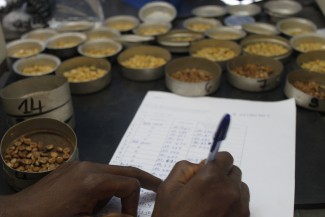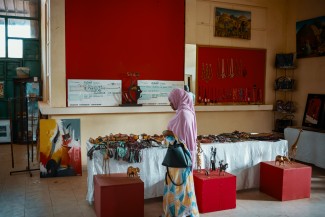The COVID-19 pandemic transformed the trade ecosystem for women in the developing world
When COVID-19 lockdowns started and borders closed in March 2020, Euphrosine saw her sales of avocado oil plummet in Rwanda. So she created an online shop on her company's website to continue selling her products.
The impacts of the COVID-19 pandemic on livelihoods, businesses and trade in least developed countries (LDCs) have been particularly pronounced. According to a WTO report, LDCs saw a 10.3% decline in exports in 2020 compared to 2019, and a 10.5% decline in imports, which led to a significant loss of income. Established and burgeoning tourism industries were brought to a halt, and economic activity suffered with international tourist arrivals collapsing by 67% in LDCs. Business ties were also severed by a lack of connectivity.
This picture of gloom has manifested even more gravely for women entrepreneurs in these countries, as they suffer more acutely from any distortions in the trade ecosystem, and this has been especially evident during the COVID-19 pandemic.
Women, trade and COVID-19
Business and trade rely on a vast ecosystem with various stakeholders. For women traders and entrepreneurs in LDCs, this includes participants along the value chain such as suppliers of raw materials, cooperatives, transporters, warehouse managers and airlines, to mention a few. Elements such as clear customs procedures, established banking systems and good internet connectivity are equally vital.
The COVID-19 pandemic disrupted these systems and stakeholders. Women entrepreneurs had to creatively devise means to continue doing business while navigating the complexities that arose from closed borders and lockdown orders. Traditional models of doing business involving physical movement of persons to facilitate transactions were no longer viable, and e-commerce and digital trade were catapulted to the fore as the most viable means of trade. Euphrosine reacted by partnering with other businesses to share the shipping costs of the bottles she needs to sell her oil.
Digital literacy remains low in LDCs, especially among women, and the general ignorance about benefits accrued from digital trade is high. Internet connectivity is very expensive and IT infrastructure are not well distributed. Studies confirm that internet penetration rates globally are 48% for women, compared to 58% for men. But even with more people in developing countries starting to use the internet, the digital gender gap is actually growing. In LDCs, only 14% of women use the internet, compared to 24% of men.
When the pandemic hit, women in LDCs lacked means of digital connectivity. Many women who had been using their mobile phones for everyday communications were not using the internet for business purposes. Important gaps existed in skills such as online marketing.
The pandemic as an impetus to go digital
Women are resilient, adaptable and quick learners. Small-scale traders at fruit and vegetable markets in Kampala, Uganda, illustrate just that. Prior to the COVID-19 pandemic, sales via digital and online platforms were almost non-existent. Following the start of pandemic and noting that business had ground to a halt in markets due to restrictions on movement, the Jumia e-commerce platform and UNDP partnered to connect women vendors to online consumers. This initiative was launched in conjunction with the Ministry of Trade, a key partner of the Enhanced Integrated Framework (EIF) in supporting Uganda's efforts to integrate into the global trading economy.
Many of the women vendors had little formal education and limited, if any, exposure to online platforms for business transactions. The initiative started by introducing the e-commerce platform to vendors in five markets, but within three weeks two more markets joined. Each market includes over 700 women across the agricultural value chain, from producers to wholesalers, retailers and exporters. The impact of introducing Jumia was powerful, and allowed women to continue earning incomes even during the lockdown.
Initiatives such as the above offer opportunities, but uptake has its challenges. Not all the women who could have benefitted have a smartphone. According to the 2020 Mobile Gender Gap Report, women across low- and middle-income countries are 8% less likely than men to own a mobile phone, which translates into 165 million fewer women than men owning a mobile phone.
The challenges are further compounded by societal and cultural expectations that women should attend to domestic chores after they return from their businesses. It's not always possible for women to juggle their caretaking and business roles.
Leveraging the local to go digital
Creative and innovative approaches are required to quickly address some of the challenges faced by women entrepreneurs in LDCs who want to enjoy the benefits of digital trade and e-commerce.
Simple solutions such as ensuring that digital platforms embrace the use of local languages provide a level of trust for women to gain interest in connectivity. Almost all women traders in LDCs subscribe to an association or business membership group. The members of these groups will usually possess varying levels of exposure to information technology, with younger women more proficient compared to older groups. Those with higher levels of exposure can be urged to support their peers through mentorship trainings, so they provide simple explanations and where possible transact on their peers’ behalf as part of on-the-job training to help them gain confidence.
Hybrid strategies combining new digital approaches with traditional approaches should be harnessed and escalated by governments and development partners to address present day challenges, particularly for women. The EIF in collaboration with the International Telecommunications Union (ITU) has launched a programme called Tech as a Driver of Women's Economic Opportunities in Burundi, Ethiopia and Haiti targeted at building digital skills for women and closing the digital gender gap. More of these interventions are needed, especially in LDCs, to help increase the number of women in business and trade, while deepening their understanding of the complexities around sustaining a successful business. These efforts will help pave the way for the women already in trade to break into regional and international markets.
A better future can be developed by building digital skills capacity, supporting gender specific digital policies that enhance women’s economic empowerment and enabling business mentorship programmes . Then the pandemic could, having wreaked havoc on business and trade, also worked as an enabler of digitalization – with women as its main benefiters.
As for Euphrosine, after a steep digital learning curve establishing the online shop for her business, she has also joined other e-commerce platforms in Rwanda to help drive sales of her avocado oil business.
If you would like to reuse any material published here, please let us know by sending an email to EIF Communications: eifcommunications@wto.org.



